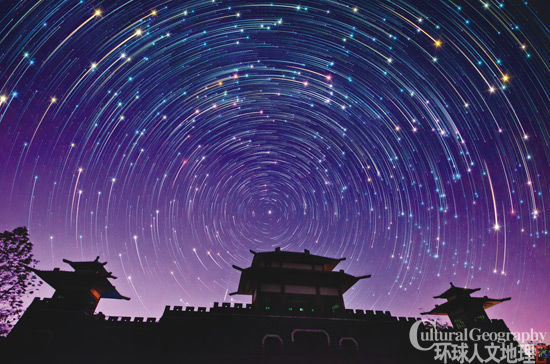Location: far away from urban areas, to avoid light pollution.
Time: avoid sunlight and moonlight. One and a half hour before sunrise and after sunset to one and a half hour for the shooting; the lunar fifteen, around the full moon that a few days can't shoot, and the first day of the month or so that a few days almost all night can shoot.
Equipment: a certain high level, have long time exposure function, camera, wide-angle lens with large aperture, shutter line, triangle and other accessories, as well as the field for the night clothes, even camping tents and other equipment.
Technical parameters: high above ISO1600, aperture should be greater than F4. Shutter time does not usually shorter than 30 seconds, if shooting stars and the Milky way, the shutter time is best not more than 1 minutes; if the shooting star track, shutter time can be a few minutes or even hours.
 The beauty of the galaxy
The beauty of the galaxyIf you use a word to sum up my experience in photography, I must say: indeed, interest is the best teacher. From 2008 since I first contact star photo, I step by step to cross the river by feeling the stones, from a "layman", studied the traditional single exposure method and superposition method of the orbit.
The same, and many fans around me started, I also feel mysterious sky photography, too high to be reached. But in fact, the stars shooting techniques is not nearly so sophisticated, generally speaking, only after several attempts to preliminary find out the doorway.
����Crossing the river by feeling the stones:
����Study the traditional single exposure photography
The start of filming is interested in the stars, is about 2007 at the end of. Previously, seen many others to sky movies, very envious, but nobody know Star Photography Master, only their own way. The first attempt was in the winter of 2007, that night, I for a long time working on its own balcony, finally only take out some bad effects of the orbit and the star line.
It was the first time I know, the stars shooting is not at whatever place, with any equipment can be taken. At least, I was the one and only 18mm wide-angle camera lens is far from enough, but because of light pollution to escape the city, definitely not the ideal location.
 The orbit.
The orbit.The real star shot attempt, in the winter of 2008. At that time, I heard that in December 17th to December 25th or 26 days, there will be continued for a week or so ursids (so named because the shower's radiant point near Ursa Minor beta), go to the outskirts and friends to discuss the the Yellow River dam were shooting star track. Unfortunately, due to lack of experience, camera sensitivity is too low, I do not will shower down. But, I first saw several meteor......
After the success of "pass" and the key role of experience, I further understand the wide-angle lens in the shooting, quickly bought himself a ultra wide angle lens. With the sky to understand more deeply, I also begin to pay close attention to each season the meteor shower. The summer of 2009, the most exciting for me is the Perseids meteor shower, this is one of the most famous, not only the quantity, but almost never in the absence of the star in the summer.
In order to better capture the Perseid meteor shower, my friends and I decided to shoot set in placeMount TaiPeak of the Heavenly Emperor.
This is after buying the ultra wide angle first shooting stars, the whole night I was about to see more than 50 meteors, but unfortunately, only recorded 1 sharp meteor photo. Although the replacement of the lens, the wide-angle, but new problems have come. Because the moon is very strong, so the orbit took me all night long is a few minutes, can not achieve the desired effect, and the bright moonlight also covers most of the meteor, we cannot use the camera to record down.
If this summer in the Taishan shooting, I realize that the lethality, then followed inJi'nanQixing shooting the first time that I feel the importance of high sensitive. Because it was dark, shutter time to 4 minutes or more to gain enough exposure, so the picture is not only the stars out of the line, and the Milky way is fuzzy...... In 2011, my old Nikon D70S finally pushed to the limit. At that time I used is still the traditional method of single long exposure shooting star track. However, in the summer high temperature, with the increase of the irradiation time, thermal noise has been difficult to accept.
While my traditional shooting method gradually walked into a dead end, an accidental opportunity, a borrowed Nikon D90 camera I used to F2 large aperture, the highest ISO6400 and 35 1.8G lens for a shooting attempt. Unexpectedly, this time with 16 tabs, obtained the first Galaxy my film. From then on, the upgrade on my schedule, after the comparison, I will target the more affordable Nikon D7000.
On one page123The next page |
No comments:
Post a Comment